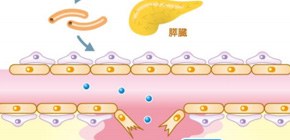
The pancreas provides a potential drug candidate for brain disease
Osaka University researchers show FGF21, a factor secreted by the pancreas, promotes remyelination in the central nervous system after injury
Brain functions are maintained by the neural network. Neural network is formed by the connection between the neurite, and this connection is supported by the wrapping of myelin. Demyelination is detected in the patients of several diseases, such as multiple sclerosis, and is associated with neurological dysfunctions. A new study in The Journal of Clinical Investigation by scientists at Osaka University shows that fibroblast growth factor (FGF) 21 promotes remyelination in mice and may be a promising key molecule for treating demyelinating diseases.
In normal development, oligodendrocyte precursor cells (OPCs) differentiate into oligodendrocytes, which are required for myelination. OPCs will proliferate around the lesions of demyelination after injury and contribute to spontaneous remyelination, but the molecular mechanism of OPCs proliferation is not fully clarified. Osaka University Associate Professor Rieko Muramatsu focused on the blood leakage around demyelinating lesion.
“Factors in the blood cannot reach the normal brain because central nervous system has blood-brain barrier. In demyelination diseases like multiple sclerosis, the blood-brain barrier around the lesion is disrupted,” she said.
Muramatsu suspected that with the breach, factors from peripheral organs secreted into the blood could now reach the brain.
To test her hypothesis, “We disrupted the vascular barrier and myelin structures in mice by injecting Lysophosphatidylcholine (LPC). We looked for circulating factors that promote OPCs proliferation and found FGF21 as a candidate,” she said.
FGF21 is secreted by the pancreas.
Mice treated with LPC showed high levels of FGF21 around demyelinated lesions leading to remyelination. This was not the case in mutant mice that could not express FGF21. Other mice that received direct administration of FGF21 to demyelinated lesions caused by LPC injection also showed increased remyelination and better recovery of neurological function.
In addition, the researchers found OPCs expressed higher levels of b–klotho, co-receptor for FGF21, following LPC injection. Without this expression, FGF21 could not promote remyelination.
“FGF21 is known to regulates metabolism, but its effects on OPC proliferation were unexpected,” said Muramatsu.
The results suggest that FGF21 has therapeutic potential for demyelinating diseases. FGF21 analogs are already being used for clinical studies on diabetes, which means its development for remyelination could go faster than had it been an untested compound.
“There are many drugs that inhibit demyelination, but none that promote remyelination. FGF21 is a new candidate that deserves more testing. The most important finding is that we show the peripheral milieu promotes central nervous system remyelination.”
Abstract
Demyelination in the central nervous system (CNS) leads to severe neurological deficits that can be partially reversed by spontaneous remyelination. Because the CNS is isolated from the peripheral milieu by the blood-brain barrier, remyelination is thought to be controlled by the CNS microenvironment. However, in this work we found that factors derived from peripheral tissue leak into the CNS after injury and promote remyelination in a murine model of toxin-induced demyelination. Mechanistically, leakage of circulating fibroblast growth factor 21 (FGF21), which is predominantly expressed by the pancreas, drives proliferation of oligodendrocyte precursor cells (OPCs) through interactions with β-klotho, an essential coreceptor of FGF21. We further confirmed that human OPCs expressed β-klotho and proliferated in response to FGF21 in vitro. Vascular barrier disruption is a common feature of many CNS disorders; thus, our findings reveal a potentially important role for the peripheral milieu in promoting CNS regeneration.

Figure 1.Remyelination is promoted by peripheral FGF21.

Figure 2. FGF21 knockout mice (FGF21 KO) show inhibition of remyelination and functional recovery after demyelination.

Figure 3.FGF21 treatment promotes human OPC proliferation.
To learn more about this research, please view the full research report entitled " Peripherally-derived FGF21 promotes remyelination in the central nervous system " at this page of the Journal of Clinical Investigation website.
Related links
